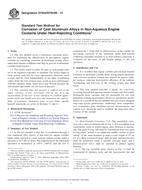We need your consent to use the individual data so that you can see information about your interests, among other things. Click "OK" to give your consent.
ASTM D7934/D7934M-14
Standard Test Method for Corrosion of Cast Aluminum Alloys in Non-Aqueous Engine Coolants Under Heat-Rejecting Conditions (Withdrawn 2023)
Automatically translated name:
Standard Test Method for Corrosion of Cast Aluminum Alloys in Non-Aqueous Engine Coolants Under Heat-Rejecting Conditions
STANDARD published on 1.6.2014
The information about the standard:
Designation standards: ASTM D7934/D7934M-14
Note: WITHDRAWN
Publication date standards: 1.6.2014
SKU: NS-39290
The number of pages: 4
Approximate weight : 12 g (0.03 lbs)
Country: American technical standard
Category: Technical standards ASTM
The category - similar standards:
Annotation of standard text ASTM D7934/D7934M-14 :
Keywords:
aluminum, anhydrous, cast aluminum alloys, corrosion, cylinder head, engine coolant, heat transfer, non-aqueous, ICS Number Code 71.100.45 (Refrigerants and antifreezes)
Additional information
| Significance and Use | ||||
|
4.1 It is essential that engine coolants prevent heat-transfer corrosion of aluminum cylinder heads during engine operation. Any corrosion products formed may deposit on interior radiator surfaces, reducing heat-transfer efficiency of the radiator. Overheating and boil-over of the cooling system may then occur. 4.2 This test method provides a means for selectively screening unused non-aqueous engine coolants and will readily distinguish those coolants that are unsuitable for use with aluminum cylinder head engines. However, satisfactory performance of a coolant in this test method does not ensure adequate long-term service performance. Additional, more comprehensive evaluations with simulated service, dynamometer, and vehicle tests should be used to establish the long-term effectiveness of the coolant. |
||||
| 1. Scope | ||||
|
1.1 This test method covers a laboratory screening procedure for evaluating the effectiveness of non-aqueous engine coolants in combating corrosion of aluminum casting alloys under heat-transfer conditions that may be present in aluminum cylinder head engines. 1.2 The values stated in either SI units or inch-pound units are to be regarded separately as standard. The values stated in each system may not be exact equivalents; therefore, each system shall be used independently of the other. Combining values from the two systems may result in non-conformance with the standard. Some values have only SI units because the inch-pound equivalents are not used in practice. 1.3 This standard does not purport to address all of the safety concerns, if any, associated with its use. It is the responsibility of the user of this standard to establish appropriate safety and health practices and determine the applicability of regulatory limitations prior to use. Some specific hazards statements are given in Sections 11 and 12. |
||||
| 2. Referenced Documents | ||||
|
We recommend:
Technical standards updating
Do you want to make sure you use only the valid technical standards?
We can offer you a solution which will provide you a monthly overview concerning the updating of standards which you use.
Would you like to know more? Look at this page.




 Cookies
Cookies
